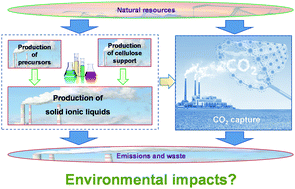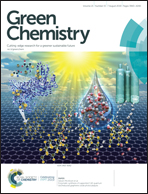Environmental sustainability of cellulose-supported solid ionic liquids for CO2 capture†
Abstract
Solid ionic liquids (SoILs) with cellulose as a support have been demonstrated recently to be effective and low-cost sorbents for CO2 capture. However, at present it is not clear whether they remove more CO2 than is released in the rest of the life cycle, including their manufacture, regeneration and disposal. It is also unknown what other impacts they may have over the whole life cycle while attempting to mitigate climate change. Therefore, this study evaluates for the first time the life cycle environmental sustainability of cellulose-supported SoILs in comparison with unsupported SoILs and some other sorbents. Four SoILs are assessed for 11 life cycle impacts, including global warming potential (GWP), with and without the cellulose support: methyltrioctyl ammonium acetate ([N1888][Ac]), tetraethyl ammonium acetate ([N4444][Ac]), tetra-octylammonium bromide ([N8888]Br) and 1-butyl-4-methylimidazolium bromide ([Bmim]Br). They are compared with one of the ILs in the liquid state (trihexyltetradecylphosphonium 1,2,4-triazolide ([P66614][124Triz])) and with three conventional sorbents: monoethanolamine (MEA), zeolite powder and activated carbon. The results show that SoILs with cellulose loading in the range of 70%–80 wt% have better environmental performance per unit mass of CO2 captured than the unsupported SoILs. The net removal of CO2 eq. over the life cycle ranges from 20% for pure [Bmim]Br to 83% for [N1888][Ac] with 75% cellulose and for [N4444][Ac] with both 75% and 80% loadings. However, pure [N8888]Br generates three times more CO2 eq. over the life cycle than it removes. Among the SoILs, [N4444][Ac] with 80% cellulose has the lowest life cycle impacts for eight out of 11 categories. When compared to the conventional sorbents, it has significantly higher impacts, including GWP. However, it is more sustainable than [P66614][124Triz]. The results of this study can be used to target the hotspots and improve the environmental performance of cellulose-supported SoILs through sustainable design.



 Please wait while we load your content...
Please wait while we load your content...